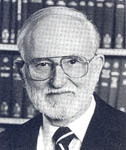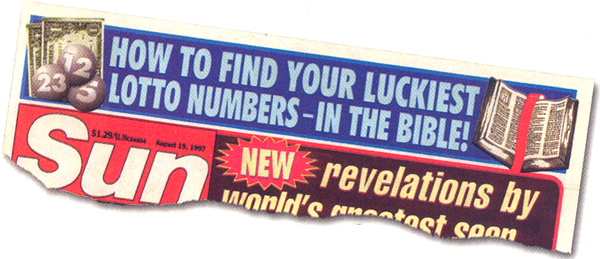Jots & Tittles
020
Marvin Pope, 1916–1997

Marvin H. Pope, a leading Bible scholar and long-time Yale professor, died during church services this past June at the age of 80. He and his wife had just returned to their pew after delivering the Scripture reading when Pope collapsed.
Pope was a professor of Near Eastern languages and civilization at Yale from 1949 to 1986 and also held an appointment at the Yale Divinity School. He was a specialist in Ugaritic, an ancient Semitic language similar to biblical Hebrew. In 1928 a farmer in northern Syria accidentally uncovered the first of what proved to be extensive remains of a city that thrived 3,400 years ago; among the finds was an archive of clay tablets. Pope’s expertise in Ugaritic led him to retranslate the entire Book of Job and the Song of Songs for the Anchor Bible series. He was especially noted for his ability to determine the proper sequence of lines on the tablets, which were often jumbled, based on how they fit on the stone. Pope also discovered that Baal, the chief Ugaritic god, was not always preeminent in the pantheon but had achieved that position by eclipsing the god El.
Pope got his start in Near Eastern languages by accident. While an undergraduate at Duke University, he was mistakenly registered for a course in Hebrew. He completed the class and went on to earn a master’s degree in Semitics. Pope received his doctorate from Yale in 1949. His article “Hosanna—What It Really Means” appeared in our April 1988 issue.
William Hallo, the Laffan Professor of Assyriology and Babylonian Literature at Yale, said, “Marvin was a delightful colleague, always ready to bring his wit and wisdom to arcane bits of biblical or ancient Near Eastern lore. He put his stamp on several generations of graduate students.”
Gleaning, Modern-Style

“When you reap the harvest of your land, you shall not wholly reap the corners of your field, nor shall you gather the gleanings of your harvest…you shall leave them for the poor and the stranger,” enjoins Leviticus 19:9–10. In an example of that biblical ruling put into practice, the Book of Ruth describes the widowed Ruth following in the wake of the harvesters to gather food for herself and for her mother-in-law, Naomi.
The biblical injunction is today a rallying cry for a network of volunteers to save food that would otherwise go to waste and to get it to the nation’s hungry. During a September meeting in Washington, members of community and religious antihunger groups, government officials, and representatives from corporations met to share strategies for reducing hunger. Billed as “Food Recovery and Gleaning—A Call to Action,” the two-day summit attracted 500 participants and was seen by 14,000 others via satellite.
An estimated 96 billion pounds of food a year go to waste in America—one quarter of all the food produced here.
Publicity is bound to help the cause. Bonnie West, who attended the conference from Charlotte, North Carolina, said donations to her city’s Community Food Rescue group doubled after a local television station reported on its efforts.
Some conference participants immediately put their values to work, collecting perfectly good but leftover cucumbers and squash from a farm in the Washington area. “This stuff just isn’t marketable,” farm owner Rod Parker told the Washington Post. “But it’s strictly cosmetic. We give them to anyone who wants them. Farmers don’t like to see food go to waste.”
The Book of Numbers

“How to Find Your Luckiest Lotto Numbers—In the Bible!” trumpets the cover of the tabloid newspaper the Sun (August 19, 1997). Inside, “Biblical scholar” Dr. Steven Harkin declares, “The Bible contains certain ‘holy numbers’ which appear time and time again.” “Harkin” recommends that lottery bettors always consider the numbers 12 (the number of Apostles, the Tribes of Israel), 3 (the crosses at Calvary, the Trinity), 40 (the years wandering in the desert), 7 (the days of creation) and several others before placing their bets. (The Society of Biblical Literature, this country’s professional organization of Bible professors, does not list 021a Steven Harkin among its members. Does anyone know him? Does he really exist?)
You do not need to be a “Biblical scholar” to notice that certain numbers do indeed occur frequently in the Bible. For a more serious discussion of the significance of these numbers, see Maureen A. Tilley, “Typological Numbers—Taking a Count of the Bible,” BR 08:03. Don’t expect any betting tips, however.
New Guests in the Hotel Room
It’s not just the Bible that can be found next to hotel beds these days. With the rise of multiculturalism, hotels are branching out as far as sacred scripture is concerned. Some Marriott hotels, for example, offer the Book of Mormon alongside the Bible (the Marriott family members are prominent in the Church of Latter Day Saints).
Hotels with many Asian visitors, such as the Nikko in San Francisco, now offer the Teachings of Buddha. “Our marketplace is much more diverse,” Valerie Ferguson, vice chairman of the American Hotel and Motel Association, told CNN. “Our industry is in fact reflecting the needs of the marketplace. In order to get those customers back and keep those customers, we feel we need to comply and honor their religious beliefs as much as possible.”
Good News for Latin Lovers

“In-ay e-thay eginning-bay Od-gay eated-cray e-thay eaven-hay and-ay e-thay earth-ay.”
Thus begins the newest translation of the Bible—in Pig Latin. This latest rendition comes to us by way of—what else?—the Internet. The unnamed toiler behind the work describes it as the 319th translation of the entire Bible (parts of the Bible have been rendered into 1,629 languages)—but the first, we are quite certain, in the porcine tongue.
The author thanks the many “writers, translators, monks, scribes, pharisees and whatnot who came before me, and especially King James and his coworkers, upon whose magnificent translation I have based this version…I hope this work will be of value to scholars, researchers, native speakers of Pig Latin, and all those who wish to further their understanding of scripture by seeing it presented in new terms. As it is said,
‘In-ay e-thay eginning-bay as-way e-thay Ord-way.’”
You can peruse the Bible, er, Ible-bay, via ftp://ftp.netcom.com/pub/ea/earl/Ible-bay/Ible-bay.html. Because of space constraints, only the books of Genesis, Job and John are available online. What did you expect, iracles-may?
Faith and Reason

A new survey of religious beliefs among American scientists shows that only a minority (40 percent) believe in God. But what is remarkable about that figure is that it has not changed in 80 years.
In 1916 researcher James Leuba shocked the nation when he found that most scientists were either atheists (45 percent) or agnostics (15 percent). He predicted that lack of faith in a supreme being would rise as education improved. To test Leuba’s theory, historian Edward J. Larson and religion writer Larry Witham replicated the earlier survey. They randomly chose 1,000 scientists listed in American Men and Women of Science, the successor to the work Leuba had used.
“Traditional Western theism has not lost its place among U.S. scientists, despite their intellectual preoccupation with material reality,” write Larson and Witham.
The new survey found differences between disciplines. Mathematicians are the most inclined to believe in God (44.6 percent), physicists and astronomers the least. In Leuba’s day, biologists led the ranks of unbelievers.
Marvin Pope, 1916–1997
Marvin H. Pope, a leading Bible scholar and long-time Yale professor, died during church services this past June at the age of 80. He and his wife had just returned to their pew after delivering the Scripture reading when Pope collapsed.
You have already read your free article for this month. Please join the BAS Library or become an All Access member of BAS to gain full access to this article and so much more.
